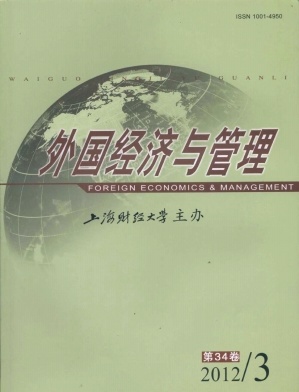后发企业能力追赶研究探析与展望
外国经济与管理 2012 年 第 34 卷第 03 期, 页码:57 - 64
摘要
参考文献
摘要
"能力追赶"是发展中国家后发企业实施赶超战略的关键。尽管追赶研究迄今已历时半个世纪,但相关文献比较分散,因而综述有关该议题的研究文献显得非常必要。本文在文献梳理的基础上,首先对后发企业进行了概念界定,然后依次从内容、过程和情境视角对既有的后发企业能力追赶研究进行了综述,最后指出了若干颇具潜力的未来研究方向。
[1]Barney J.Firm resources and sustained competitive advantage[J].Journal of Management,1991,17(1):99-120.
[2]Bell M and Pavitt K.Technological accumulation and industrial growth:Contrasts between developed and develo-ping countries[J].Industrial and Corporate Change,1993,2(1):157-210.
[3]Breschi S,et al.Technological regimes and Schumpeterian patterns of innovation[J].Economic Journal,2000,110(3):388-410.
[4]Cai J and Tylecote A.Corporate governance and technological dy-namism of Chinese firms in mobile telecommunications:A quanti-tative study[J].Research Policy,2008,37(10):1790-1811.
[5]Chang S-J,et al.When and how does business group affiliation promote firm innovation?A tale of two emerging economies[J].Organiztion Science,2006,17(5):637-656.
[6]Child J and Tsai T.The dynamic between firms’environmen-tal strategies and institutional constraints in emerging econo-mies:Evidence from China and Taiwan[J].Journal of Mana-gement Studies,2005,42(1):95-125.
[7]Cho H-D and Lee J-K.The developmental path of networking capability of catch-up players in Korea’s semiconductor indus-try[J].R&D Management,2003,33(4):411-423.
[8]Dahlman C J,et al.Managing technological development:Les-sons from the newly industrializing countries[J].World Develo-pment,1987,15(6):759-775.
[9]Dorothy L-B.Core capabilities and core rigidities:A paradox in managing new product development[J].Strategic Manage-ment Journal,1992,13(S.I.):111-125.
[10]Dutrénit G.Building technological capabilities in latecomer firms:A review essay[J].Science Technology&Society,2004,9(2):209-241.
[11]Ernst D.Catching-up crisis and industrial upgrading:Evolu-tionary aspects of technological learning in Korea’s electro-nics industry[J].Asia Pacific Journal of Management,1998,15(2):247-283.
[12]Ernst D and Kim L.Global production networks,knowledge diffusion,and local capability formation[J].Research Policy,2002,31(8/9):1417-1429.
[13]Etzkowitz H and Brisolla S N.Failure and success:The fate of in-dustrial policy in Latin America and South East Asia[J].Re-search Policy,1999,28(4):337-350.
[14]Figueiredo P N.Learning processes features and technologi-cal capability-accumulation:Explaining inter-firm diffe-rences[J].Technovation,2002,22(11):685-698.
[15]Figueiredo P N.Learning,capability accumulation and firms differences:Evidence from latecomer steel[J].Industrial and Corporate Change,2003,12(3):607-643.
[16]Gao X.Technological capability catching up:Follow the nor-mal way or deviate[D].MIT Sloan School of Management,2003.
[17]Gerschenkron A.Economic development in historical per-spective[M].Cambridge,MA:Belknap,1962.
[18]Gerstenfeld A and Wortzel L H.Strategies for innovation in developing countries[J].Sloan Management Review,1977,19(1):57-68.
[19]Hayek F A.The use of knowledge in society[J].American E-conomic Review,1945,35(4):519-530.
[20]Hobday M.East Asian latecomer firms:Learning the tech-nology of electronics[J].World Development,1995,23(7):1171-1193.
[21]Hobday M,et al.Approaching the innovation frontier in Ko-rea:The transition phase to leadership[J].Research Policy,2004,33(10):1433-1457.
[22]Hobday M.Firm-level innovation models:Perspectives on re-search in developed and developing countries[J].Technology櫒櫒櫒櫒櫒櫒櫒櫒櫒櫒櫒櫒櫒櫒櫒櫒櫒櫒櫒櫒櫒櫒櫒Analysis&Strategic Management,2005,17(2):121-146.
[23]Kim L.Stages of development of industrial technology in a developing country:A model[J].Research Policy,1980,9(3):254-277.
[24]Lall S.Technological capabilities and industrialization[J].World Development,1992,20(2):165-186.
[25]Lee J,et al.Technology development processes:A model for a developing country with a global perspective[J].R&D Management,1988,18(3):235-250.
[26]Mathews J A and Cho D-S.Combinative capabilities and or-ganizational learning in latecomer firms:The case of the Ko-rean semiconductor industry[J].Journal of World Business,1999,34(2):139-156.
[27]Mathews J A.Competitive advantages of the latecomer firm:A resource-based account of industrial catch-up strategies[J].Asia Pacific Journal of Management,2002,19(4):467-488.
[28]Nonaka I,et al.A firm as a knowledge-creating entity:A new perspective on the theory of the firm[J].Industrial and Cor-porate Change,2000,9(1):1-20.
[29]Pettigrew A M.Longitudinal field research on change:Theory and practice[J].Organization Science,1990,1(3):267-292.
[30]Teece D J,et al.Dynamic capabilities and strategic manage-ment[J].Strategic Management Journal,1997,18(7):509-533.
[2]Bell M and Pavitt K.Technological accumulation and industrial growth:Contrasts between developed and develo-ping countries[J].Industrial and Corporate Change,1993,2(1):157-210.
[3]Breschi S,et al.Technological regimes and Schumpeterian patterns of innovation[J].Economic Journal,2000,110(3):388-410.
[4]Cai J and Tylecote A.Corporate governance and technological dy-namism of Chinese firms in mobile telecommunications:A quanti-tative study[J].Research Policy,2008,37(10):1790-1811.
[5]Chang S-J,et al.When and how does business group affiliation promote firm innovation?A tale of two emerging economies[J].Organiztion Science,2006,17(5):637-656.
[6]Child J and Tsai T.The dynamic between firms’environmen-tal strategies and institutional constraints in emerging econo-mies:Evidence from China and Taiwan[J].Journal of Mana-gement Studies,2005,42(1):95-125.
[7]Cho H-D and Lee J-K.The developmental path of networking capability of catch-up players in Korea’s semiconductor indus-try[J].R&D Management,2003,33(4):411-423.
[8]Dahlman C J,et al.Managing technological development:Les-sons from the newly industrializing countries[J].World Develo-pment,1987,15(6):759-775.
[9]Dorothy L-B.Core capabilities and core rigidities:A paradox in managing new product development[J].Strategic Manage-ment Journal,1992,13(S.I.):111-125.
[10]Dutrénit G.Building technological capabilities in latecomer firms:A review essay[J].Science Technology&Society,2004,9(2):209-241.
[11]Ernst D.Catching-up crisis and industrial upgrading:Evolu-tionary aspects of technological learning in Korea’s electro-nics industry[J].Asia Pacific Journal of Management,1998,15(2):247-283.
[12]Ernst D and Kim L.Global production networks,knowledge diffusion,and local capability formation[J].Research Policy,2002,31(8/9):1417-1429.
[13]Etzkowitz H and Brisolla S N.Failure and success:The fate of in-dustrial policy in Latin America and South East Asia[J].Re-search Policy,1999,28(4):337-350.
[14]Figueiredo P N.Learning processes features and technologi-cal capability-accumulation:Explaining inter-firm diffe-rences[J].Technovation,2002,22(11):685-698.
[15]Figueiredo P N.Learning,capability accumulation and firms differences:Evidence from latecomer steel[J].Industrial and Corporate Change,2003,12(3):607-643.
[16]Gao X.Technological capability catching up:Follow the nor-mal way or deviate[D].MIT Sloan School of Management,2003.
[17]Gerschenkron A.Economic development in historical per-spective[M].Cambridge,MA:Belknap,1962.
[18]Gerstenfeld A and Wortzel L H.Strategies for innovation in developing countries[J].Sloan Management Review,1977,19(1):57-68.
[19]Hayek F A.The use of knowledge in society[J].American E-conomic Review,1945,35(4):519-530.
[20]Hobday M.East Asian latecomer firms:Learning the tech-nology of electronics[J].World Development,1995,23(7):1171-1193.
[21]Hobday M,et al.Approaching the innovation frontier in Ko-rea:The transition phase to leadership[J].Research Policy,2004,33(10):1433-1457.
[22]Hobday M.Firm-level innovation models:Perspectives on re-search in developed and developing countries[J].Technology櫒櫒櫒櫒櫒櫒櫒櫒櫒櫒櫒櫒櫒櫒櫒櫒櫒櫒櫒櫒櫒櫒櫒Analysis&Strategic Management,2005,17(2):121-146.
[23]Kim L.Stages of development of industrial technology in a developing country:A model[J].Research Policy,1980,9(3):254-277.
[24]Lall S.Technological capabilities and industrialization[J].World Development,1992,20(2):165-186.
[25]Lee J,et al.Technology development processes:A model for a developing country with a global perspective[J].R&D Management,1988,18(3):235-250.
[26]Mathews J A and Cho D-S.Combinative capabilities and or-ganizational learning in latecomer firms:The case of the Ko-rean semiconductor industry[J].Journal of World Business,1999,34(2):139-156.
[27]Mathews J A.Competitive advantages of the latecomer firm:A resource-based account of industrial catch-up strategies[J].Asia Pacific Journal of Management,2002,19(4):467-488.
[28]Nonaka I,et al.A firm as a knowledge-creating entity:A new perspective on the theory of the firm[J].Industrial and Cor-porate Change,2000,9(1):1-20.
[29]Pettigrew A M.Longitudinal field research on change:Theory and practice[J].Organization Science,1990,1(3):267-292.
[30]Teece D J,et al.Dynamic capabilities and strategic manage-ment[J].Strategic Management Journal,1997,18(7):509-533.
引用本文
江诗松, 龚丽敏, 魏江. 后发企业能力追赶研究探析与展望[J]. 外国经济与管理, 2012, 34(3): 57–64.
导出参考文献,格式为:





 5826
5826  261
261

